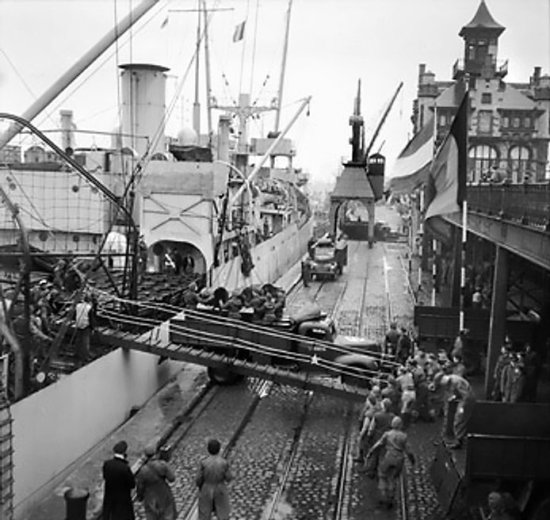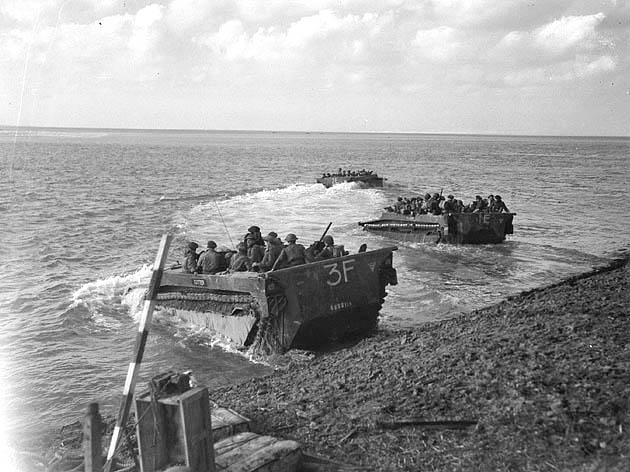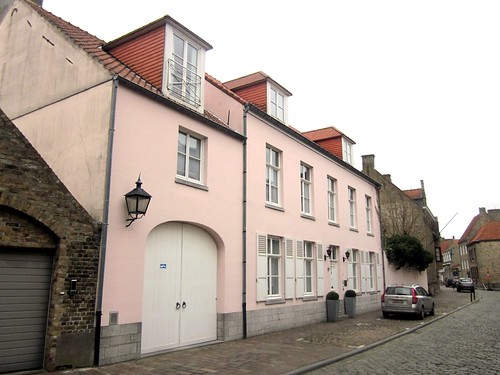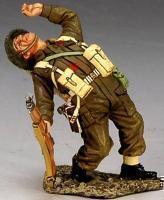T
 The Siege of Dunkirk in World War II occurred from September 1944 when units of the Second Canadian Division surrounded the heavily fortified city and port of Dunkirk.
The Siege of Dunkirk in World War II occurred from September 1944 when units of the Second Canadian Division surrounded the heavily fortified city and port of Dunkirk.  German units withstood initial probing attacks, and as the opening of the port ofAntwerp became a higher priority,
German units withstood initial probing attacks, and as the opening of the port ofAntwerp became a higher priority,  Dunkirk was "masked" by Allied troops (notably the 1st Czechoslovak Armoured Brigade) and left to the rear of the Canadian Army. The garrison remained in Dunkirk until the general German surrender in May 1945. In doing so, the garrison denied the Allies the use of the port, whose facilities had been demolished.
Dunkirk was "masked" by Allied troops (notably the 1st Czechoslovak Armoured Brigade) and left to the rear of the Canadian Army. The garrison remained in Dunkirk until the general German surrender in May 1945. In doing so, the garrison denied the Allies the use of the port, whose facilities had been demolished. The fortress, commanded by AdmiralFriedrich Frisius,
The fortress, commanded by AdmiralFriedrich Frisius,  eventually surrendered unconditionally to Brigade General Alois Liška, the commander of the Czechoslovakbrigade group,
eventually surrendered unconditionally to Brigade General Alois Liška, the commander of the Czechoslovakbrigade group,  on 9 May 1945.The 1st Canadian Army had been allocated the left of the 21st Army Group's line of advance and General Bernard Montgomery, the commander of 21st Army Group, had directed them to clear the Channel Ports before continuing into the Netherlands. Most of these ports, however, had been heavily fortified and, despite the generally poor quality of the garrisons, it was necessary to mount full-scale major assaults.
on 9 May 1945.The 1st Canadian Army had been allocated the left of the 21st Army Group's line of advance and General Bernard Montgomery, the commander of 21st Army Group, had directed them to clear the Channel Ports before continuing into the Netherlands. Most of these ports, however, had been heavily fortified and, despite the generally poor quality of the garrisons, it was necessary to mount full-scale major assaults.The ports were needed to supply the allied armies and the lack of such facilities had halted or slowed much offensive activity. Montgomery had estimated that the Channel Ports would be sufficient for his needs and this view persisted until mid-September. Under pressure from Dwight Eisenhower, the Allied Supreme Commander, Montgomery modified his instructions to the Canadian commander, Henry Crerar, on 13–14 September thus: "Early use of Antwerp so urgent that I am prepared to give up operations against Calais and Dunkirk" and: "Dunkirk will be left to be dealt with later; for the present it will be merely masked.
on 13–14 September thus: "Early use of Antwerp so urgent that I am prepared to give up operations against Calais and Dunkirk" and: "Dunkirk will be left to be dealt with later; for the present it will be merely masked.
 on 13–14 September thus: "Early use of Antwerp so urgent that I am prepared to give up operations against Calais and Dunkirk" and: "Dunkirk will be left to be dealt with later; for the present it will be merely masked.
on 13–14 September thus: "Early use of Antwerp so urgent that I am prepared to give up operations against Calais and Dunkirk" and: "Dunkirk will be left to be dealt with later; for the present it will be merely masked.Action against Calais continued (see Operation Undergo), at least partly due to the need to silence the heavy artillery sited nearby. The forces that might have been used to capture Dunkirk were released to assist on the Scheldt  and thus open access to the largely undamaged port of Antwerp. Instead, smaller Allied forces held a perimeter around the city.In the first weeks of the siege, while Allied forces were being deployed on the Scheldt, several units took short turns at containing Dunkirk. The 5th Canadian Infantry Brigade, part of 2nd Canadian
and thus open access to the largely undamaged port of Antwerp. Instead, smaller Allied forces held a perimeter around the city.In the first weeks of the siege, while Allied forces were being deployed on the Scheldt, several units took short turns at containing Dunkirk. The 5th Canadian Infantry Brigade, part of 2nd Canadian  Infantry Division, was relieved by the 4th Special Service Brigade (a Royal Marines Commando formation), which was in turn relieved by the 154th Infantry Brigade. However, the bulk of the siege was performed by the 1st Czech Armoured Brigade from early October until the final surrender ;below a company's worth of 28mm Bolt ActionBritish/Canadian infantry.This is the blofg Rabbits in my basement see what the blogger says= I was quite pleased with the detail of sculpting and lack of flash.
Infantry Division, was relieved by the 4th Special Service Brigade (a Royal Marines Commando formation), which was in turn relieved by the 154th Infantry Brigade. However, the bulk of the siege was performed by the 1st Czech Armoured Brigade from early October until the final surrender ;below a company's worth of 28mm Bolt ActionBritish/Canadian infantry.This is the blofg Rabbits in my basement see what the blogger says= I was quite pleased with the detail of sculpting and lack of flash.
 and thus open access to the largely undamaged port of Antwerp. Instead, smaller Allied forces held a perimeter around the city.In the first weeks of the siege, while Allied forces were being deployed on the Scheldt, several units took short turns at containing Dunkirk. The 5th Canadian Infantry Brigade, part of 2nd Canadian
and thus open access to the largely undamaged port of Antwerp. Instead, smaller Allied forces held a perimeter around the city.In the first weeks of the siege, while Allied forces were being deployed on the Scheldt, several units took short turns at containing Dunkirk. The 5th Canadian Infantry Brigade, part of 2nd Canadian  Infantry Division, was relieved by the 4th Special Service Brigade (a Royal Marines Commando formation), which was in turn relieved by the 154th Infantry Brigade. However, the bulk of the siege was performed by the 1st Czech Armoured Brigade from early October until the final surrender ;below a company's worth of 28mm Bolt ActionBritish/Canadian infantry.This is the blofg Rabbits in my basement see what the blogger says= I was quite pleased with the detail of sculpting and lack of flash.
Infantry Division, was relieved by the 4th Special Service Brigade (a Royal Marines Commando formation), which was in turn relieved by the 154th Infantry Brigade. However, the bulk of the siege was performed by the 1st Czech Armoured Brigade from early October until the final surrender ;below a company's worth of 28mm Bolt ActionBritish/Canadian infantry.This is the blofg Rabbits in my basement see what the blogger says= I was quite pleased with the detail of sculpting and lack of flash.
For paints I used Tamiya'sKhaki for the uniforms, and Americana Khaki Tan for the webbing. Games Workshop Boltgun for the gun metal and AmericanaLampblack for the boots. Cermacoat Burnt Umber for the wooden stocks, boot soles, hair and bases. I then coated everyone in the Army Painter dip. the dip does leave a gloss finish on the figures but it does give a good hard protective coat. One figure fell onto the cement floor during the photo shoot and received nary a scratch or chip!

The German garrison consisted of a wide variety of units, including Navy and Air Force personnel, as well as Army and Fortress units. There was also a 2,000 strong Waffen-SS detachment. The total strength was in excess of 10,000 men. Many of these were remnants of five Army divisions which had been mauled during the Normandy campaign and had retreated to Dunkirk. The town itself was heavily fortified, and well-supplied for a lengthy siegeThe Canadians approached Dunkirk from the south west. On 7–8 September, the 5th Canadian Infantry Brigade captured Bourbourg,  about 13 km (8.1 mi) from the city itself. The German outer perimeter ran through the villages of Mardyck
about 13 km (8.1 mi) from the city itself. The German outer perimeter ran through the villages of Mardyck , Loon-Plage
, Loon-Plage , Spycker,
, Spycker, Bergues
Bergues  and Bray-Dunes
and Bray-Dunes , from 7–12 km (4.3–7.5 mi) from Dunkirk. The Calgary Highlanders
, from 7–12 km (4.3–7.5 mi) from Dunkirk. The Calgary Highlanders  attacked Loon-Plage on 7 September against very heavy opposition and suffered enough casualties that each of its companies was reduced to less than 30 men.
attacked Loon-Plage on 7 September against very heavy opposition and suffered enough casualties that each of its companies was reduced to less than 30 men. The village was gained on the 9th only when the Germans withdrew. During the next ten days, Canadian units nibbled away at the German perimeter, taking Coppenaxfort on the 9th,
The village was gained on the 9th only when the Germans withdrew. During the next ten days, Canadian units nibbled away at the German perimeter, taking Coppenaxfort on the 9th,  Mardyck on the 17th, both west of the city, Bergues on the 15th and Veurne
Mardyck on the 17th, both west of the city, Bergues on the 15th and Veurne , Nieuport
, Nieuport  (greatly aided by precise intelligence received from the Belgian White Brigade, the national resistance movement) and De Panne, east of Dunkirk
(greatly aided by precise intelligence received from the Belgian White Brigade, the national resistance movement) and De Panne, east of Dunkirk , in Belgium. Bray Dunes
, in Belgium. Bray Dunes  and nearby Ghyvelde,
and nearby Ghyvelde, both just within France, were taken on the 15th September, with air support after initial attacks had failed.
both just within France, were taken on the 15th September, with air support after initial attacks had failed.
 about 13 km (8.1 mi) from the city itself. The German outer perimeter ran through the villages of Mardyck
about 13 km (8.1 mi) from the city itself. The German outer perimeter ran through the villages of Mardyck , Loon-Plage
, Loon-Plage , Spycker,
, Spycker, Bergues
Bergues  and Bray-Dunes
and Bray-Dunes , from 7–12 km (4.3–7.5 mi) from Dunkirk. The Calgary Highlanders
, from 7–12 km (4.3–7.5 mi) from Dunkirk. The Calgary Highlanders  attacked Loon-Plage on 7 September against very heavy opposition and suffered enough casualties that each of its companies was reduced to less than 30 men.
attacked Loon-Plage on 7 September against very heavy opposition and suffered enough casualties that each of its companies was reduced to less than 30 men. The village was gained on the 9th only when the Germans withdrew. During the next ten days, Canadian units nibbled away at the German perimeter, taking Coppenaxfort on the 9th,
The village was gained on the 9th only when the Germans withdrew. During the next ten days, Canadian units nibbled away at the German perimeter, taking Coppenaxfort on the 9th,  Mardyck on the 17th, both west of the city, Bergues on the 15th and Veurne
Mardyck on the 17th, both west of the city, Bergues on the 15th and Veurne , Nieuport
, Nieuport  (greatly aided by precise intelligence received from the Belgian White Brigade, the national resistance movement) and De Panne, east of Dunkirk
(greatly aided by precise intelligence received from the Belgian White Brigade, the national resistance movement) and De Panne, east of Dunkirk , in Belgium. Bray Dunes
, in Belgium. Bray Dunes  both just within France, were taken on the 15th September, with air support after initial attacks had failed.
both just within France, were taken on the 15th September, with air support after initial attacks had failed.
It had become clear that the German defenders were not about to be expelled without a major assault. Given the  armoured car by die cast models
armoured car by die cast models
 armoured car by die cast models
armoured car by die cast modelsneed to open up the Scheldt to Antwerp and the likelihood that Dunkirk would be of limited use as a supply port as a result of its demolition, the major Canadian units were redeployed. Nearby Ostende had fallen easily to the Canadians when the Germans withdrew, and its port was partially opened on 28 September, easing the Allies' supply problems. Dunkirk was no longer worth the effort of its captureThe Allied forces around Dunkirk were to contain the German garrison and minimise their inclination to fight on by aggressive reconnaissance, artillery and air bombardment andpropaganda. Coastal supply routes used by German E-Boats and air supply drops were to be cut off.
had fallen easily to the Canadians when the Germans withdrew, and its port was partially opened on 28 September, easing the Allies' supply problems. Dunkirk was no longer worth the effort of its captureThe Allied forces around Dunkirk were to contain the German garrison and minimise their inclination to fight on by aggressive reconnaissance, artillery and air bombardment andpropaganda. Coastal supply routes used by German E-Boats and air supply drops were to be cut off.
 had fallen easily to the Canadians when the Germans withdrew, and its port was partially opened on 28 September, easing the Allies' supply problems. Dunkirk was no longer worth the effort of its captureThe Allied forces around Dunkirk were to contain the German garrison and minimise their inclination to fight on by aggressive reconnaissance, artillery and air bombardment andpropaganda. Coastal supply routes used by German E-Boats and air supply drops were to be cut off.
had fallen easily to the Canadians when the Germans withdrew, and its port was partially opened on 28 September, easing the Allies' supply problems. Dunkirk was no longer worth the effort of its captureThe Allied forces around Dunkirk were to contain the German garrison and minimise their inclination to fight on by aggressive reconnaissance, artillery and air bombardment andpropaganda. Coastal supply routes used by German E-Boats and air supply drops were to be cut off.
Of all of the German fortress garrisons on the Channel coast, Dunkirk appears to have been the most resilient.They had thwarted early probes by the Canadians with sufficient aggression to dissuade them from a full assault. By this stage, other priorities had come into play, compelling the 'Canucks' to persist in aggressive patrolling and successful local counter-attacks.

On the night of 26–27 September, the Germans attempted to take advantage of the local inexperience of the recently-deployed 154th Brigade. Two serious attacks were mounted, against the 7th Black Watch in Ghyvelde and the 7th Argylls at nearby Bray-Dunes Plage. Both were beaten off, but only after the Argylls' headquarters had been partially occupied and houses in Ghyvelde had been destroyed.

On 4 October, a 36-hour truce was agreed between the two sides, at the initiative of the French Red Cross, to allow the evacuation of 18,000 French civilians and Allied and German wounded. This passed without incident and was even extended to allow the Germans to restore defences that had been removed to allow the evacuation.

Once deployed, Czech forces executed frequent raids into Dunkirk's eastern suburbs, for nuisance effect and to take prisoners. There was a flurry of attacks and retaliatory counter-attacks, mostly on Dunkirk's eastern side, in November 1944. Conditions for besiegers and besieged were difficult in the winter. The low-lying ground outside  the city had been flooded to form part of the defences and adjacent land easily became water-logged, hampering movement and making life unpleasant. Canadian artillerymen reported that gun-pits needed to be bailed out, the sides of dugouts collapsed and transport became mired. This was mitigated by leave in nearby towns and in Lille. The defenders were stuck with poor food, deficient health care and harsh discipline.After the general German surrender, the garrison surrendered unconditionally to Alois Liška on May 9, 1945.
the city had been flooded to form part of the defences and adjacent land easily became water-logged, hampering movement and making life unpleasant. Canadian artillerymen reported that gun-pits needed to be bailed out, the sides of dugouts collapsed and transport became mired. This was mitigated by leave in nearby towns and in Lille. The defenders were stuck with poor food, deficient health care and harsh discipline.After the general German surrender, the garrison surrendered unconditionally to Alois Liška on May 9, 1945.
 the city had been flooded to form part of the defences and adjacent land easily became water-logged, hampering movement and making life unpleasant. Canadian artillerymen reported that gun-pits needed to be bailed out, the sides of dugouts collapsed and transport became mired. This was mitigated by leave in nearby towns and in Lille. The defenders were stuck with poor food, deficient health care and harsh discipline.After the general German surrender, the garrison surrendered unconditionally to Alois Liška on May 9, 1945.
the city had been flooded to form part of the defences and adjacent land easily became water-logged, hampering movement and making life unpleasant. Canadian artillerymen reported that gun-pits needed to be bailed out, the sides of dugouts collapsed and transport became mired. This was mitigated by leave in nearby towns and in Lille. The defenders were stuck with poor food, deficient health care and harsh discipline.After the general German surrender, the garrison surrendered unconditionally to Alois Liška on May 9, 1945.
Substantial reserves of food and ammunition remained in Dunkirk.

No comments:
Post a Comment